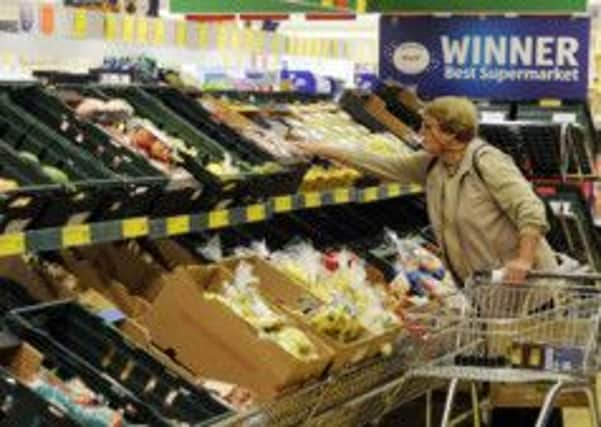The Price is right for discount supermarkets


IT WAS the sort of fanfare difficult to imagine just a few years ago when the supermarket sector’s discounters were widely regarded as austere outlets of limited choice with little to recommend them other than rock-bottom prices.
If such perceptions still rang true today, the celebrations to mark last week’s opening of the 50th Aldi store in Scotland would have bordered on surreal. They included a bagpiper, a DJ and prizes for the first 100 customers at Inshes Retail Park in Inverness. It wasn’t as if Aldi was new to the city. It has been trading in the centre of Inverness since 2012.
Advertisement
Hide AdAdvertisement
Hide AdLater that evening, Aldi went on to take the prestigious Retailer of the Year title at the so-called “Retail Oscars” in London. It and fellow German grocer Lidl were both attending the event for the first time, and between them bagged three of the top awards.
There were no such gongs for Morrisons, which on Thursday was forced to admit that profits would halve this year as it expects to fall further behind in market share to the thriving discounters like Aldi, as well as those better-equipped in the online and convenience store arena. Morrisons chief executive, Dalton Philips, chose to take aim at the discounters, declaring them the cause of the biggest crisis ever in the history of British supermarkets. Furthermore, he claimed that the shift in consumer spending is no longer a cyclical trend driven by the economic downturn.
“Today is an important day,” Philips said. “We are facing some big structural changes and it is the biggest challenge facing the industry since the 1950s and the advent of the supermarket.”
It’s a view shared by many, including Mike Watkins, head of retail and business insight at consumer intelligence group Nielsen.
The latest figures published on Friday show that Aldi and Lidl now account for 8.8 per cent of all supermarket sales, against 6.6 per cent a year ago.
Evidence suggests they are continuing to siphon off custom from the mainstream supermarkets, with one in five of Aldi’s visitors during February shopping there for the first time.
“But the major supermarkets are not losing shoppers like many people have said, what they are losing is spend,” says Watkins, pointing to a rise in “shopper promiscuity”.
During the four weeks to 1 March, consumers spent 0.1 per cent less at the UK’s leading grocery chains, taking the average spend to £25 per visit. Meanwhile, discount chains now take an average of £17 per visit.
Advertisement
Hide AdAdvertisement
Hide AdWhile the discounters are unlikely to ever gain a dominant position, Watkins believes there is more headroom for them to grab market share.
The “natural ceiling” in the UK tends to be between 12 and 15 per cent, but in Europe, the average market share for discounters is 19 per cent.
The duration of the squeeze on consumer spending has aided their cause, giving shoppers time to get accustomed to store layouts and the products on offer. The longer this continues, the more likely their “cherry-picking” shopping habits will become ingrained.
Chris Longbottom, director of Kantar Worldpanel, says shoppers have been lured by other factors as well.
“We have seen acceleration in the growth of the discounters in the last couple of years, and there are two reasons for that,” he explains. “The first is that they are opening more stores. The second is that groups like Aldi started going into advertising, and they were followed by Lidl.”
Morrisons has said it will spend £1 billion during the next five years to bring its prices down to a level similar to those of the discounters, raising industry fears that others such as Tesco and Asda will be sucked into a profit-sapping price war. Investors responded by knocking 6.2 per cent off the value of the food retail sector on Thursday, led by a decline of nearly 12 per cent in Morrisons’ shares.
“We will see the major multiples focusing more on price, but what they have got to watch out for is they don’t wipe out their profitability,” Longbottom said. “It is a tough old game.”
When UK discounters first started gaining significant share in 2008, market leader Tesco and third-ranked Asda both slashed prices in a bid to stem the flow of defectors. Both are keeping a close eye on pricing this time around, but neither has declared all-out war, perhaps indicating the futility of that strategy.
Advertisement
Hide AdAdvertisement
Hide AdDespite these doubts, Philips insisted last week that Morrisons is following the best path to recovery.
“We overlap with the discounters more than anybody else, our customers have felt the austerity programme more than anybody else and these are bold steps to put us back on track,” he said.
“This is the right plan for this business in this landscape. We can’t ignore this structural shift.”
For others such as Asda, Sainsbury and Tesco, it may be a matter of hanging in there until better economic times return. While the discounters will likely retain a bigger share of the market than before the recession, the reach of the major multiples sets them up to benefit most from higher spending.
One outside possibility for the mainstream retailers would be to open their own discount chains, a tactic that has been widely adopted in countries such as France. However, Kantar’s Longbottom says this would be an expensive ploy.
“There have not been any suggestions of that sort of thing in this country yet, but if the situation gets too extreme, who knows?”